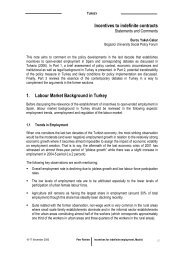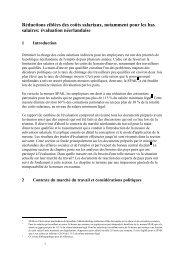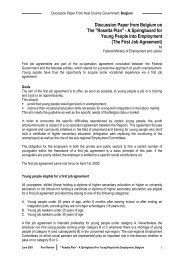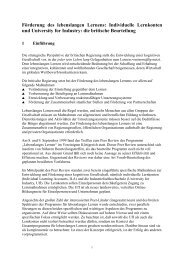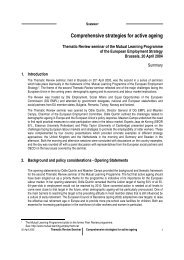Reform of Severance Pay Law in Austria - mutual learning programme
Reform of Severance Pay Law in Austria - mutual learning programme
Reform of Severance Pay Law in Austria - mutual learning programme
Create successful ePaper yourself
Turn your PDF publications into a flip-book with our unique Google optimized e-Paper software.
DISCUSSION PAPER<br />
discourag<strong>in</strong>g hir<strong>in</strong>g and fir<strong>in</strong>g. This could have negative implications for productivity growth and<br />
adoption to technological change. On the other hand, EPL could provide <strong>in</strong>centives for employees<br />
to participate <strong>in</strong> tra<strong>in</strong><strong>in</strong>g, if there is <strong>in</strong>sufficient <strong>in</strong>surance aga<strong>in</strong>st loss <strong>of</strong> firm-specific human<br />
capital. The key issue for policy is how to reconcile the employers’ need for flexibility <strong>in</strong> hir<strong>in</strong>g and<br />
fir<strong>in</strong>g with that <strong>of</strong> workers for employment security. Blanchard and Tirole (2004) discuss<br />
unemployed <strong>in</strong>surance and EPL together <strong>in</strong> a framework with risk-averse worker and risk-neutral<br />
entrepreneurs. They claim that a lay<strong>of</strong>f tax can be efficiency enhanc<strong>in</strong>g, lead<strong>in</strong>g firms to<br />
<strong>in</strong>ternalise the costs <strong>of</strong> unemployment.<br />
Accord<strong>in</strong>g to the OECD (2006) severance payment can be a barrier to efficiency-enhanc<strong>in</strong>g<br />
labour reallocation by discourag<strong>in</strong>g workers from quitt<strong>in</strong>g their current jobs to move to better jobs.<br />
This problem arises where high tenure workers are entitled to significant severance payments, if<br />
they are laid-<strong>of</strong>f from the current job, but loose this entitlement if they voluntarily quit jobs. Aga<strong>in</strong>st<br />
this background the OECD (2006) mentioned the reform <strong>of</strong> severance pay <strong>in</strong> <strong>Austria</strong> as<br />
address<strong>in</strong>g this problem. <strong>Austria</strong> has reformed its severance pay legislation by chang<strong>in</strong>g from a<br />
performance-oriented to a contribution-oriented system <strong>of</strong> <strong>in</strong>dividual sav<strong>in</strong>gs accounts. The<br />
reform extends the coverage <strong>of</strong> the system to all employees <strong>in</strong> the private sector, but lower<br />
average payments are expected.<br />
In this paper we describe the reform <strong>of</strong> severance pay law and discuss some implications. The<br />
rema<strong>in</strong>der <strong>of</strong> the paper is organized as follows. Section 2 provides some background <strong>in</strong>formation<br />
about the <strong>Austria</strong>n labour market and the pension system. Section 3 gives a description <strong>of</strong> the<br />
reform <strong>of</strong> the severance payment system and the problems driv<strong>in</strong>g the reform. We present figures<br />
concern<strong>in</strong>g the development <strong>of</strong> the new system. Distributional issues and the role <strong>of</strong> severance<br />
pay as funded occupational pension are discussed. Section 4 gives an assessment <strong>of</strong> the impact<br />
<strong>of</strong> the new system on labour mobility and concludes.<br />
2. The <strong>Austria</strong>n Labour Market<br />
In <strong>in</strong>ternational comparison the <strong>Austria</strong>n labour market situation is favourable, although a gradual<br />
deterioration has occurred over the last 25 years. Unemployment is traditionally low <strong>in</strong> <strong>Austria</strong>,<br />
the unemployment rate amounted to 5.2 % <strong>in</strong> 2005. The employment rate is around 68 % and<br />
above the EU-15 average. However, the employment rate <strong>of</strong> older workers is one <strong>of</strong> the lowest <strong>in</strong><br />
Europe.<br />
The unemployment rate has been cont<strong>in</strong>ually ris<strong>in</strong>g dur<strong>in</strong>g the 1980’s and 1990’s, with the only<br />
decl<strong>in</strong>e occurr<strong>in</strong>g dur<strong>in</strong>g 1998-2001. However, as a consequence <strong>of</strong> slow economic development<br />
and <strong>in</strong>creased labour supply unemployment has risen aga<strong>in</strong> dur<strong>in</strong>g the last years.<br />
Accord<strong>in</strong>g to social <strong>in</strong>surance register data the average number <strong>of</strong> <strong>in</strong>dividuals <strong>in</strong> active dependent<br />
employment <strong>in</strong> 2004 was 3,078,544. The average number <strong>of</strong> <strong>in</strong>dividuals registered as<br />
unemployed amounted to 243,880. These numbers hide, however, the strong labour turnover <strong>in</strong><br />
the <strong>Austria</strong>n economy. In 2004, a total <strong>of</strong> 1,454,000 jobs were taken up and 1,423,000<br />
employment contracts were term<strong>in</strong>ated (BMWA 2005). Stiglbauer et al. (2003) f<strong>in</strong>d that yearly job<br />
creation and destruction rates <strong>in</strong> <strong>Austria</strong> are comparable to the US, at least as one does not<br />
control for firm structure.<br />
30 Nov - 1 Dec 2006 Peer Review <strong>Reform</strong> <strong>of</strong> <strong>Severance</strong> <strong>Pay</strong> <strong>Law</strong>, Vienna<br />
8



